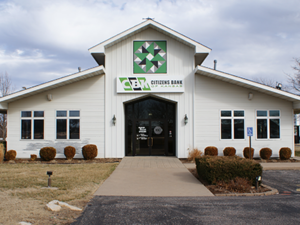The clock that used to decorate the front of the El Dorado branch of Citizens Bank of Kansas had long ceased to keep accurate time when the bank decided to replace it last year. The company which could service the clock was based in Iowa, and summoning its workers every time the clock’s mechanism went awry no longer made sense, said Shannon Beal, branch president in the southern Kansas town of about 13,000.

Built in the mid-1990s, the white-sided branch shared obvious visual DNA with the barns which surrounded it. So Citizens turned to a local design movement, said Jane Deterding, chair of the Kingman, Kan.-based bank. It was Deterding’s husband who made the ultimate suggestion: Why not lean into the agricultural character of the building and add a barn quilt? “We got the idea out there and thought, yeah, that fits with the architecture of this building and our community there,” Deterding said.
Barn quilts aren’t made of fabric, and it’s not even necessary that they hang on barns. The colorful decorations share geometric motifs with their cloth namesakes, though, and were begun in Ohio as a way to memorialize a departed relative. Since that start, they’ve spread across the country in largely rural areas. There are websites dedicated to tracking their locations, and some people follow “quilt trails” across various locations, including in the Sunflower State.
Once they’d settled on their choice, staff at the $478 million bank turned to a local expert. “I’m kind of the barn quilt person here in Dexter,” said Steve Joyce, a high school teacher in a nearby town who’s had a decade-long career of crafting the panels along with his students. He uses them as part of his Kansas history and civics curriculum, giving freshmen and seniors different sized panels to work with as a hands-on project. Through word of mouth, the groups are commissioned to make two to three barn quilts a year for local businesses, ranchers and farmers or civic projects.

For Citizens Bank, “we had to make sure that all of the dimensions were exact,” Beal said, “so it would perfectly line up to where that clock was.” The bank chose a pattern in its existing logo colors, but for those in need of inspiration, Joyce keeps a few reference texts of quilt options. Some come from Facebook groups or local quilting knowledge. Designs themed around local sports teams or using the color palette from a favored implement manufacturer are particularly popular, he said.
“The kids love to get their hands into the art aspect of them,” said Joyce, who is also mayor and “unofficial spokesman” of the southern Kansas town.
Typically, two smaller panels of plywood are assembled into an 8-foot square. The design is sketched onto its primed surface, and several layers of paint are applied using tape to guide the lines. The younger classes create 2-foot squares, some of which adorn a park in Dexter dedicated to its status as the birthplace of helium, while the older students work with full-sized versions. Joyce estimates that he’s assembled a library of 70-80 different shades of paint to meet commission requirements. The particular shade of green Citizens Bank required to echo its logo required a bit of legwork to get right, he recalled. The entire process took about a month, with the quilt installed in El Dorado at the beginning of September.
“It was a really neat little addition to our bank and it kind of sets us apart because our building looks more like a barn,” Beal said. “It brightens up our building.”
